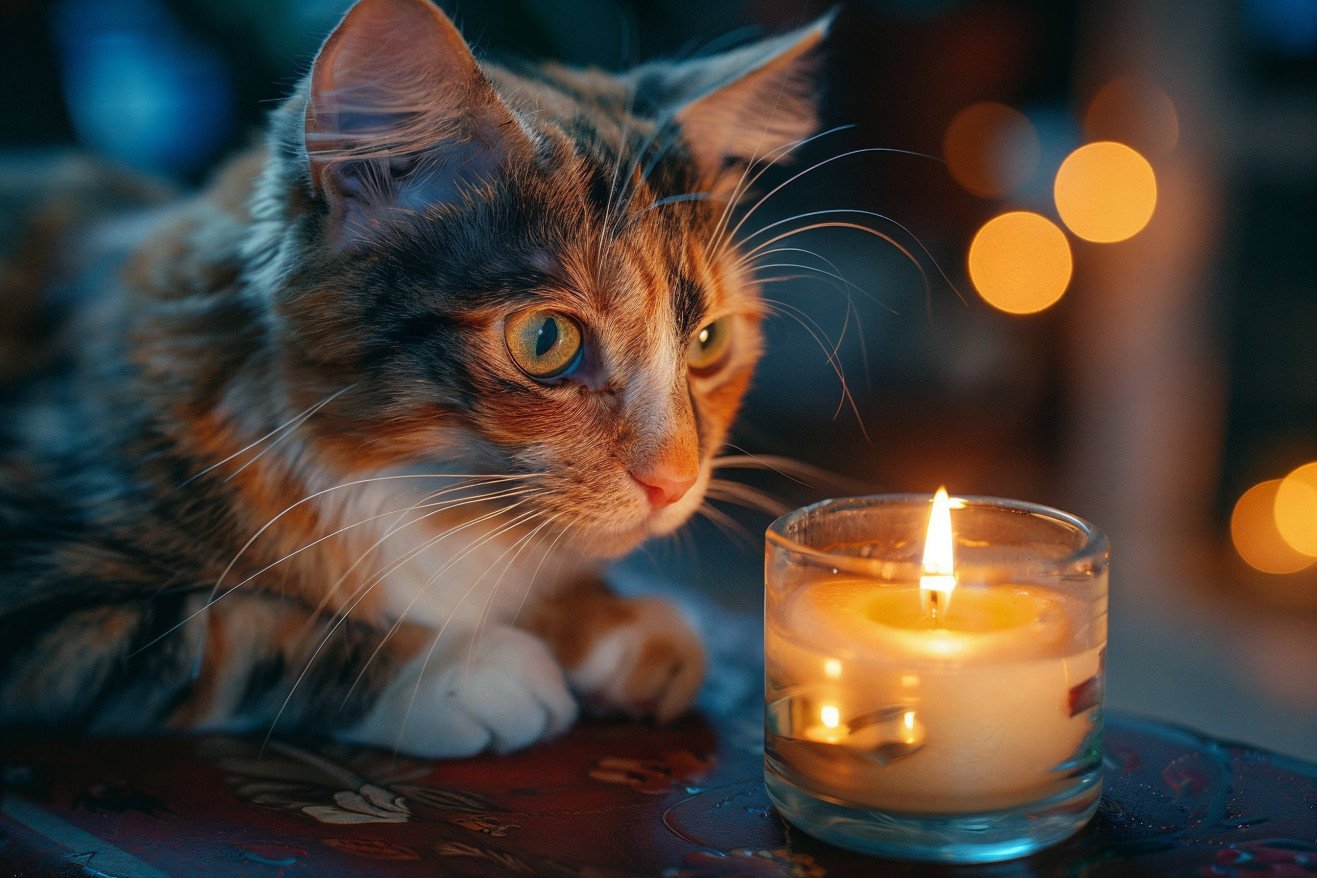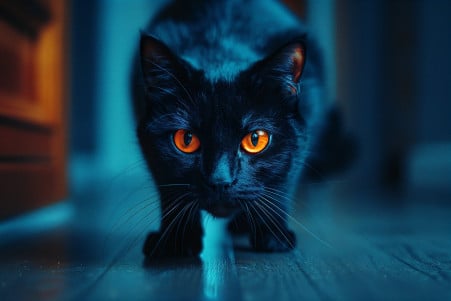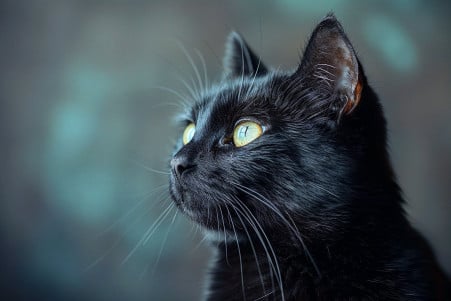Can Cats See Fire? Unveiling Feline Vision and Flame Perception
22 February 2024 • Updated 20 February 2024

Cats’ eyes are full of wonder, but how do they see the mysterious movement of fire? Cats can see fire. Yes, cats can see fire. Their vision, which is adapted to low-light conditions, allows them to see the light and movement of fire. That said, cats may not see all the colors in the fire, as they are more attuned to light and dark than color.
This article will explore information from veterinary medicine and animal behavior research to help us learn more about cat vision and how cats see fire. In this investigation, we will look at the anatomy of cats’ eyes and how it helps them see light and movement, compare cats’ vision to human vision, and explore cats’ reactions to fire.
By the time we’re done, you’ll know everything you need to know about how cats experience this mesmerizing phenomenon.
Can cats see fire?
The Tapetum Lucidum: A Look Inside the Cat’s Eye
The cat’s eye is an evolutionary masterpiece that’s been fine-tuned for night vision. The high number of rod cells is one of the most important structural elements that help cats see in the dark. According to Pets Health Mag, cats have a lot of these light-sensitive cells, which are essential for vision in low-light conditions. This is especially important for cats when they’re watching the barely perceptible movement of a flame in the dark.
The tapetum lucidum, a reflective layer that acts like a mirror located behind the retina, is another important component. As Hill’s Pet describes, the tapetum lucidum reflects light that has already passed through the retina back through it, giving the retina a second chance to register visual information in low-light situations.
The shape of cats’ pupils is yet another important factor in their ability to see in the dark. Their pupils are elliptical, and they can open and close to a much greater degree than human pupils in response to changes in light.
This allows cats to precisely control the amount of light that enters their eyes, which is especially important when they’re hunting at dawn and dusk, the times of day when their prey is most active.
These structural elements help cats see even the smallest movements and shapes, including the flickering of a flame, which is one of the reasons they’re so captivated by it. These elements also help cats see well in low-light conditions, enabling them to be the ultimate night stalkers. With their eyesight perfectly adapted to the nuances of dim light, cats are true masters of the twilight world.
Seeing Red: How Cats Perceive the Color of Fire
Despite their impressive night vision, cats’ color perception is another matter, especially when it comes to the bright red and orange colors of fire. Cats have dichromatic vision, which means they have two types of color receptors, as opposed to the three that humans have.
DVM360 explains that cats’ inability to distinguish between red, green, and yellow makes their color vision similar to that of color-blind humans, who also have trouble seeing red and green.
As a result, while cats can see the brightness and movement of fire, the warm colors of a fire are less clear. Live Science notes that cats’ vision is biased toward blues and grays, which makes reds and oranges look more like greens, and purples look more like another shade of blue.
The bottom line is that cats see the flicker and flow of fire more than its color. Business Insider concurs, noting that while cats can’t see fine detail or rich color, they have better night vision than humans.
This means the flickering light and movement of fire is more noticeable to a cat than the color of the fire. So, as cats interact with this primal source of light, their experience is defined by movement and contrast rather than the colors that humans can see.
Knowing this about how cats see the world helps us understand the subtleties of their relationship with their surroundings, which are defined by a world of shapes and contrasts rather than the full spectrum of colors.
Why Do Cats Like Fire?
The behavior of cats to be drawn to fire can be explained by a few different factors, all of which are rooted in their evolution.
For example, cats are drawn to light and warmth, and while this is an instinct that can be traced back to their ancestors, it’s also a behavior that’s still relevant today.
This is because cats are naturally drawn to warm and cozy environments, and while this can include sunbeams and other warm spots around the house, it can also include the warmth of a fire. While this behavior can be comforting, it can also be dangerous, especially when cats are drawn to the light and warmth of a fire.
Another reason cats are drawn to fire is that they can be drawn to the heat it produces, even though they can be susceptible to heatstroke. This is because cats don’t have the same cooling systems as humans, and while they can sweat through their paw pads and groom themselves, these methods of cooling down aren’t as effective as sweating.
This means that cats can be more susceptible to heatstroke than humans, especially when they’re drawn to the heat of a fire and don’t know when to back away from it.
To help keep cats safe, owners can take steps to protect them from fire and other heat sources. For example, pet gates can be used to keep cats away from fireplaces, and beds can be placed at a safe distance from fireplaces. In addition, fireplaces can be made safer by using screens and having them inspected regularly.
When thinking about these behaviors, it’s also important to think about how a cat’s senses can impact their interactions with fire, which will help us think beyond the visual sense.
Understanding How Fire Affects Animal Senses
The way animals perceive their environment is heavily influenced by their interactions with fire. According to a paper in Ecology Letters, an animal’s evolutionary relationship with fire can determine how different species perceive fire and its cues, and these relationships can vary widely between species.
For example, animals that are adapted to fire may have a more finely tuned sensitivity to it, like the lizards that have been found to have a stronger response to the sound of wildfires in a paper available on ScienceDirect.
These lizards, which had survived a wildfire, were more sensitive to the sounds of fire, including crackling and popping, than lizards from unburned areas.
A paper in Fire Ecology builds on this idea by noting that animals detect and respond to fire using a variety of sensory cues, including the visual sight of flames, the heat of the fire, and the chemicals in smoke.
The responses to these cues can be everything from immediate avoidance to attraction—some animals are even attracted to fire, likely due to the fact that it can create opportunities, such as the chance to find lots of food.
These papers show that fire has a nuanced impact on animals’ sensory systems and behavior and that it’s important to take into account an animal’s relationship with fire when trying to predict their response to it.
This knowledge of how other animals experience and respond to fire helps explain why cats, with their heightened senses and natural behaviors, are drawn to the warmth and light of fire. This understanding of the animal kingdom as a whole helps set the stage for a deeper exploration of how cats and other animals interact with the fires in their environment.
The Orchestra of Senses: How Cats Perceive Their Fiery World
Cats use a complex combination of senses, in addition to their excellent vision, to move through the world. The sense of smell, in particular, is especially important in how cats perceive stress and threats.
As a study in PMC points out, the areas of the brain that are responsible for a cat’s stress response are closely tied to the sense of smell. This means that cats may be able to use their sense of smell to pick up on changes in their environment, including the distinct odors that fires produce.
In addition to their sense of smell, cats have excellent hearing, which means they can hear ultrasonic frequencies and even the faint sound of a fire crackling. Cats also use their sense of touch, which includes the information they get from their whiskers and skin, to pick up on changes in air flow and temperature, which can alert them to the presence of a fire.
By combining these three senses—smell, hearing, and touch—cats are able to build a complete picture of the world around them, including the presence of a fire.
This multi-sensory approach enables cats to quickly respond to threats or appropriately interact with stimuli, which helps them survive in a world where human and natural elements are constantly colliding. Since cats’ environments are always in flux, their ability to use all of their senses is key to their health and safety.
Takeaways on Cat Vision and Fire Perception
In wrapping up our investigation of cat vision and their perception of fire, several important takeaways emerge that shed light on the many ways in which cats see fire differently.
From the structural wonders of the tapetum lucidum and high rod cell count that make cats’ night vision so extraordinary to the limitations of their dichromatic color vision that make the colors of fire less vivid, cats’ vision is a world where movement and contrast are more important than color.
The way cats see fire can be understood through the anatomy of the feline eye, which in combination with their other senses, provides the biological basis for how cats experience light and heat. This is also important for cat owners to understand, as it emphasizes the importance of being careful to protect our furry friends from the lure and potential hazards of fire.
In the end, it’s apparent that cats’ sensory and perceptual experiences with fire are not only of biological interest but also have important implications for their safety and well-being in human environments. The relationship between cat vision and fire perception is as interesting as it is multi-faceted, and it highlights the complex interplay of sensory systems that determine how cats perceive the world around them.


